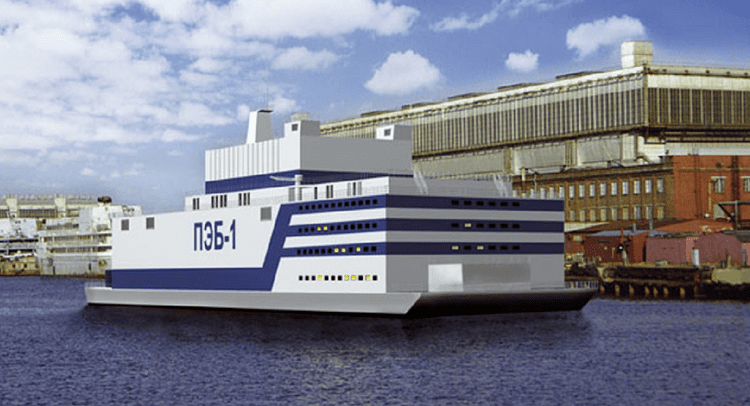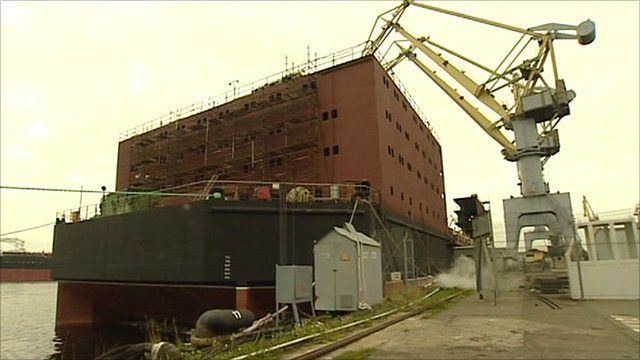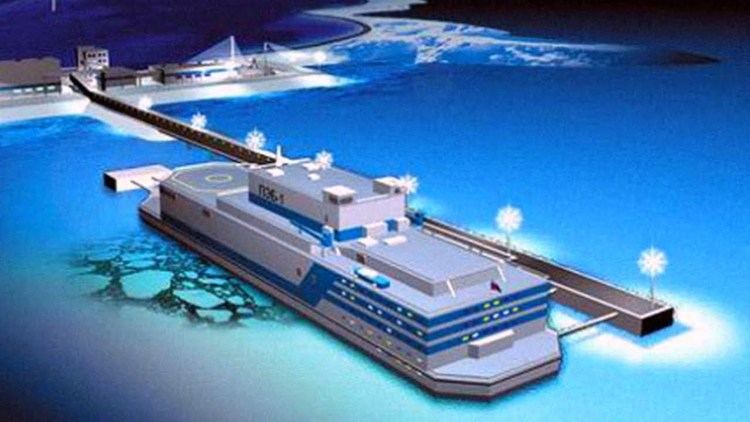Building 1 Displacement 21,500 tonnes | Planned at least 7 | |
Type Nuclear power station barge Similar VVER, Balakovo Nuclear Power Pl, Leningrad Nuclear Power Pl, Obninsk Nuclear Power Pl, Smolensk Nuclear Power Pl | ||
Floating nuclear power stations (Russian: плавучая атомная теплоэлектростанция малой мощности, ПАТЭС ММ - lit. floating combined heat and power (CHP) low-power nuclear station) are vessels designed by Rosatom.
Contents

They are self-contained, low-capacity, floating nuclear power plants. The stations are to be mass-produced at shipbuilding facilities and then towed to the destination ports of the cities and towns experiencing deficit of power due to industrialization.
The work on such projects dates back to MH-1A, which was built in the 1960s into the hull of a World War II Liberty Ship; however, the Rosatom project is the first mass-produced floating nuclear power plant. The initial plan was to manufacture at least seven of the vessels by 2015.

History

The modular power plant is descended from Russia's more than 6500 reactor-years with ship propulsion reactor experience. In 2000 the project for a floating power station began when the Ministry for Atomic Energy of the Russian Federation (Rosatom) chose Severodvinsk in Arkhangelsk Oblast as the construction site, Sevmash was appointed as general contractor. Construction of the first power station, the Akademik Lomonosov, started on 15 April 2007 at the Sevmash Submarine-Building Plant in Severodvinsk. However, in August 2008 construction works were transferred to the Baltic Shipyard in Saint Petersburg, which is also responsible for the construction of future vessels. Akademik Lomonosov was launched on 1 July 2010, at a cost of 6 billion rubles (232 m$). In 2015 construction of a second vessel starting in 2019 was announced by Russia’s state nuclear corporation Rosatom.
Technical characteristics

The floating nuclear power station is a non-self propelled vessel. It has length of 144.4 metres (474 ft), width of 30 metres (98 ft), height of 10 metres (33 ft), and draught of 5.6 metres (18 ft). The vessel has a displacement of 21,500 tonnes and a crew of 69 people.

Each vessel of this type has two modified KLT-40 naval propulsion reactors together providing up to 70 MW of electricity or 300 MW of heat, or cogeneration of electricity and heat for district heating, enough for a city with a population of 200,000 people. It could also be modified as a desalination plant producing 240,000 cubic meters of fresh water a day.

Smaller modification of the plant will be fitted with two ABV-6M reactors with the electrical power around 18 MWe (megawatts of electricity).
The much larger VBER-300 917MW thermal or 325 MWe and the slightly larger RITM-200 55 MWe reactors have both been considered as a potential energy source for these floating nuclear power stations.
Contractors
The hull and sections of vessels are to be built by the Baltic Shipyard in Saint Petersburg. Reactors are designed by OKBM Afrikantov and assembled by Nizhniy Novgorod Research and Development Institute Atomenergoproekt (both part of Atomenergoprom). The reactor vessels are produced by Izhorskiye Zavody. Kaluga Turbine Plant supplies the turbo-generators.
Fueling
The floating power stations need to be refueled every three years while saving up to 200,000 metric tons of coal and 100,000 tons of fuel oil a year. The reactors are supposed to have a lifespan of 40 years. Every 12 years, the whole plant will be towed home and overhauled at the wharf where it was constructed. The manufacturer will arrange for the disposal of the nuclear waste and maintenance is provided by the infrastructure of the Russian nuclear industry. Thus, virtually no radiation traces are expected at the place where the power station produced its energy.
Safety
Environmental groups are concerned that floating plants will be more vulnerable to accidents and terrorism than land-based stations. They point to a history of naval and nuclear accidents in Russia and the former Soviet Union, including the Chernobyl disaster of 1986. Russia does have 50 years of experience operating a fleet of nuclear-powered icebreakers that are also used for scientific and Arctic tourism expeditions. The Russians have commented that a nuclear reactor that sinks, such as the similar reactor involved in the Kursk explosion, can be raised and probably put back into operation.
The 2011 Japanese nuclear accidents due to the 2011 Tōhoku earthquake and tsunami provide a sharp contrast to some comparative safety advantages of floating nuclear plants. Land based nuclear facilities must be designed for severe ground accelerations due to earthquakes. Many are placed close to a seacoast for access to sea water for cooling. Coastal locations tend to be the areas of maximum tsunami damage, requiring protective design and risk of catastrophic failure. A floating facility, near a coast but not in shallow water, can avoid the worst problems of earthquakes and tsunamis. In deep enough water, tsunamis have minimal effect on floating structures, and earthquakes transmit much less force to them. In the event of an accident, terrorist attack, or other calamity, it is essential to keep the water moderated and cooled reactor core covered with water. An emergency measure can be to lower the core into the sea. In the worst case, accidental sinking or intentional scuttling will keep sea water on the core and prevent atmospheric release - again, especially in deep enough water. Finally, land based nuclear power plants can be expensive to build on-site, difficult to maintain or refuel and after retirement dangerous and expensive to clean up. A floating plant is towed to a facility that handles multiple such tasks.
A 2004 book on Russian floating nuclear power stations was written by a number of authors, including "Vladimir Kuznetsov, formerly of the Russian Federal Inspectorate for Nuclear and Radiation Safety; Alexey Yablokov, a biologist, former environmental advisor to the Russian president and president of the Center for Russian Environmental Policy; Yevgeney Simonov, senior engineer at the Obninsk nuclear power plant; Vladimir Desyatov, an engineer who worked in nuclear submarine construction; and Alexander Nikitin." The book concludes that such stations are impossible to protect against terrorism, that safety cannot be guaranteed ("The only question is how serious the emergency and its consequences."), and that an accident would be uniquely difficult to contain. Besides that, the book argues that such stations would be uneconomic.
Locations
Floating nuclear power stations are planned to be used mainly in the Russian Arctic. Five of these will be used by Gazprom for offshore oil and gas field development and for operations on the Kola and Yamal peninsulas. Other locations include Dudinka on the Taymyr Peninsula, Vilyuchinsk on the Kamchatka Peninsula and Pevek on the Chukchi Peninsula. In 2007, Rosatom signed an agreement with the Sakha Republic to build a floating plant for its northern parts, using smaller ABV reactors.
According to Rosatom, 15 countries, including China, Indonesia, Malaysia, Algeria, Namibia, Cape Verde and Argentina, have shown interest in hiring such a device. It has been estimated that 75% of the world’s population live within 100 miles of a port city.
